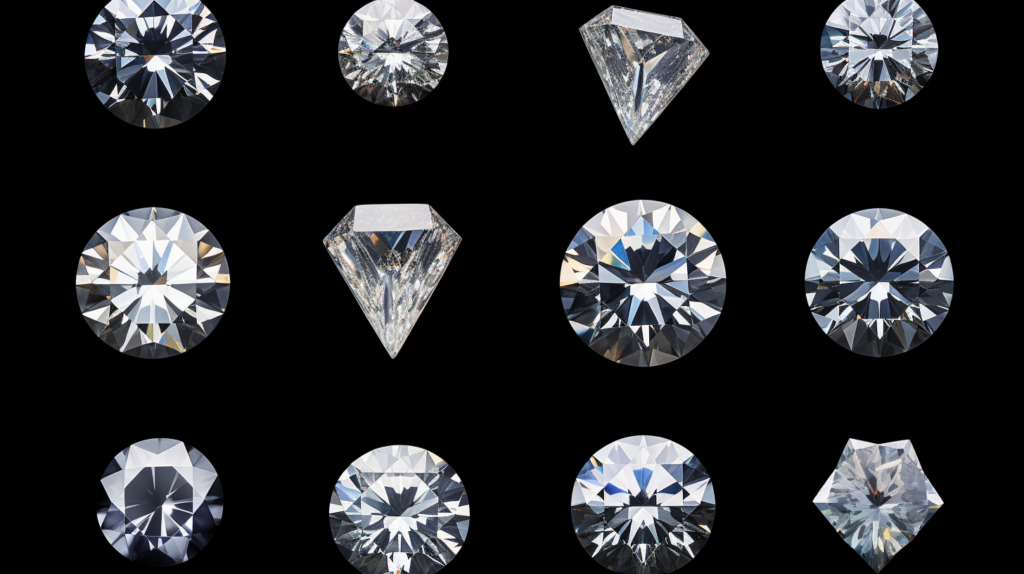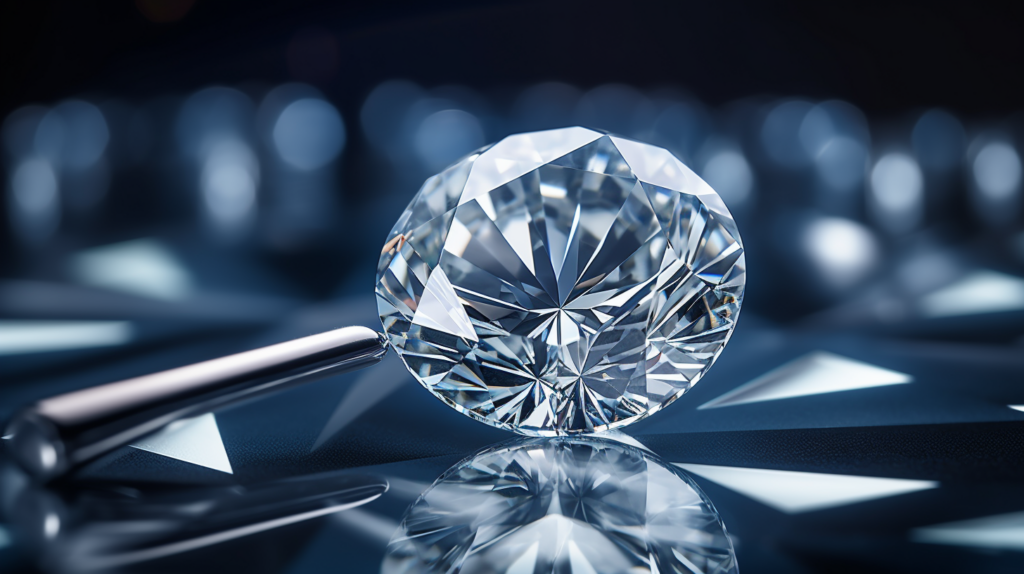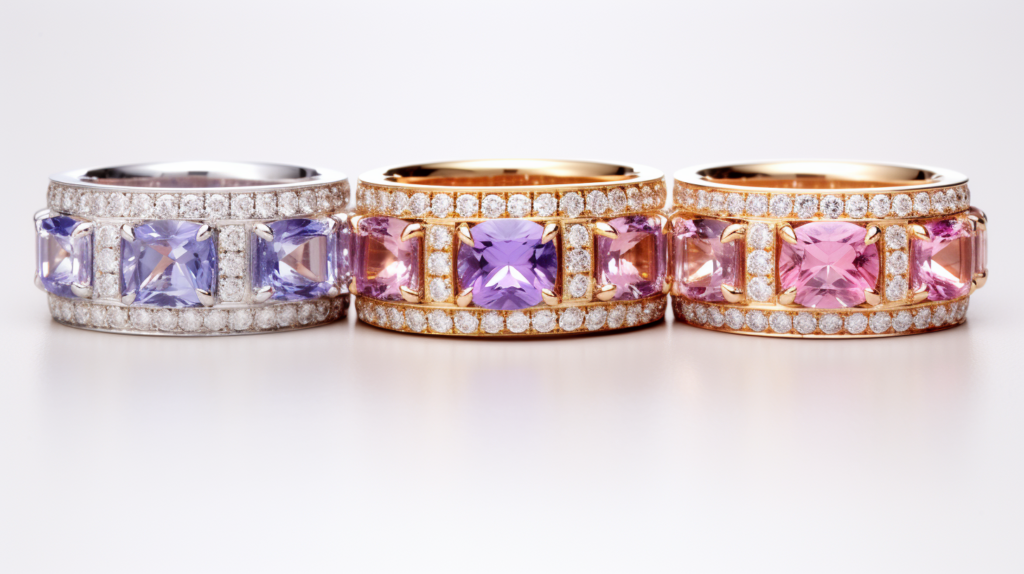4Cs Diamonds Buying Guide: Welcome to your essential guide on the 4Cs of diamonds! We’re just as passionate about these sparkling gems as you are. So, let’s embark on an exciting journey together to unlock the mysteries behind diamond quality.
From the importance of diamond carat weight to the allure of the color grade, the precision of the diamond clarity grade, and the mastery of the cut grade, we’re about to explore the depths of these facets.
Let’s boost our knowledge and confidence with BrighterGuide, ensuring we make savvy choices regarding the diamond-buying process.
Ready to sparkle? Let’s unravel the world of diamonds!
Key Takeaways
- The 4Cs of diamonds, encompassing diamond carat weight, diamond color grade, diamond clarity grade, and diamond cut, are essential criteria that determine a diamond’s quality and value.
- A diamond’s cut grade, responsible for its symmetry, proportions, and light reflection, is often viewed as the most crucial aspect influencing its brilliance. Explore the exceptional brilliance of Blue Nile diamonds, expertly crafted for perfect cut, symmetry, and light reflection.
- While the diamond carat weight measures the weight of the diamond, its appearance and value are majorly influenced by its cut, color, and clarity.

In this post, we’ll explore:
The 4Cs Of Diamond Quality
When it comes to the attributes that define a diamond’s beauty and value, the 4Cs lead the way. This universal method encompasses diamond carat weight, diamond color grade, diamond clarity grade, and diamond cut.
Firstly, the carat weight. It’s all about how much the diamond weighs, not necessarily its size. Remember, two diamonds might share the same carat weight but might differ in appearance due to their diamond shapes and cut.
Transitioning to the color grade, we find that colorless diamonds are highly prized. The color grading scale starts from D, signifying a completely colorless diamond, and goes up to Z, where a diamond might have a slight yellow or light brown shade. This diamond color can significantly influence both its look and value.

Now, let’s delve into the clarity grade. This criterion looks at the internal characteristics and external characteristics – termed inclusions and blemishes. Clarity diamonds are graded from FL (flawless) to I2, denoting the presence of visible inclusions. Fewer inclusions mean a higher diamond clarity grade, translating to a more valuable gem.
Finally, we reach the cut grade, often considered the most vital aspect. The diamond cut determines the stone’s symmetry, proportions, and ability to reflect light. A well-cut diamond will captivate with its brilliance, playing with light in the most enchanting way.
Having understood the 4Cs, it’s time to discuss the diamond’s characteristics.
The Characteristics of Diamonds
When analyzing a diamond’s attributes, primarily focusing on its quality is essential.
The 4cs are indispensable in determining a diamond’s allure and worth. Evaluating the diamond cut, diamond color, diamond clarity, and diamond carat weight helps pinpoint the diamond’s overall stature.
Diamond Quality
To determine a diamond’s quality, factors such as the diamond cut, diamond color, diamond clarity, and diamond carat weight are paramount. Grasping these characteristics is vital for making an informed purchase. Moreover, always watch out for diamond certification – it’s your guarantee of a quality diamond. With the right balance of these elements, finding your perfect diamond that fits both preference and budget becomes a breeze.
Types Of Diamond Cuts
There’s an array of diamond cuts, each contributing uniquely to the diamond’s radiance. The cut reflects the diamond’s shape and facet arrangement, heavily influencing its dazzle.
Three primary diamond cuts dominate the scene: brilliant cut, step cut, and mixed cut.
Brilliant diamonds are structured to maximize their sparkle, having precise angles for optimal light play. Their scintillation makes them a top pick for diamond engagement rings.

Step-cut diamonds, contrasting with the previous, boast rectangular facets that offer a different kind of charm. Their elegance is more subdued, perfect for vintage designs. They focus on showcasing the diamond’s clarity, emphasizing the stone’s natural allure.
Meanwhile, mixed-cut diamonds blend the brilliant and step cuts. They incorporate both triangular and rectangular facets, ensuring a harmonious light play. If you’re after a diamond with modern flair, this is your go-to cut.
When selecting your diamond, considering the diamond cut grade along with the diamond color grading and diamond clarity grade ensures a harmonious, dazzling gem.
How To Set Diamonds According To Color
Maximizing a diamond’s beauty often involves setting it according to its color. When you’re in the phase of diamond shopping, the gem’s color can significantly dictate its overall charm and aesthetic.
Here’s a quick guide:
1. Setting Match: Go for a setting that elevates the diamond color. White diamonds shine best in platinum or white gold settings, whereas color diamonds get an uplift from yellow or rose gold.
2. Prong Settings for White Diamonds: This setting type lets more light flood the diamond, amplifying its radiance, especially vital for white diamonds.
3. Concealing Imperfections: Got a diamond with visible inclusions? Opt for bezel or halo settings. They mask imperfections while adding a touch of elegance.
4. Metal Color and Contrast: Play with contrasts. For instance, a white diamond in a yellow-gold setting can create a captivating visual allure.
5. Professional Touch: Always seek guidance from diamond professionals. Their expertise ensures your diamond’s brilliance shines at its peak.

Why Do The 4Cs Matter
The 4cs offer an agreed-upon standard, serving as a touchstone for evaluating diamond quality. The diamond cut influences its brilliance, the diamond color denotes its hue, the diamond clarity inspects for blemishes or inclusions, and the diamond carat weight reflects its weight.
These guidelines empower diamond customers, ensuring informed decisions reign supreme in the diamond industry.
- Ensuring Quality: The diamond grading report acts as a testament to a diamond’s quality. Skilled grader teams, like those from the American Gem Society, follow strict standards to grade each individual diamond. This brings an objective grade into the mix, assisting buyers in making informed decisions.
- Budget and Value: Diamond price increases as you climb the ladder of excellence, especially when moving within the excellent range. But this doesn’t mean compromising on beauty. A si2 diamond, for instance, might have slight inclusions but could offer more in terms of carat size, striking a balance between price and beauty.
- Personalizing Choices: Whether it’s for an engagement ring or another piece of jewelry, understanding the 4cs allows customization based on personal preference. Whether you prioritize a larger-carat diamond or aim for a gem-quality diamond with top clarity rating, the choice becomes yours to make.
- Demystifying Myths: A common misconception might be that larger diamonds always equate to better value. But a larger-carat diamond with a poor cut might not have the same brilliance as a smaller, well-cut stone. Basic knowledge of the 4cs can eradicate such misconceptions.
- Future Investments: For those considering diamonds as long-term investments, knowing the 4cs is crucial. Factors like the diamond’s crystal structure or even unique aspects like diamond fluorescence can impact its future value. Having a diamond certificate further ensures that you’re making a sound investment.
Which of the 4 C’s is the Most Important
Each ‘C’ among the 4Cs holds its significance. However, if one were to shine brighter, it’d arguably be the Diamond Cut. This factor predominantly determines the diamond’s brilliance.
Cut
Diamond Cut stands paramount in evaluating diamonds. Here’s why:
- Balance in Proportions: Diamond Cutters aim for balance, ensuring maximum brilliance.
- Brilliance Levels: A well-cut diamond reflects light, maximizing its return, and offering a mesmerizing sparkle.
- Grading: Diamond Grades from GIA range from Poor to Excellent, with the latter being the most sought after.
- Fluorescence: The cut can affect how a diamond reacts to ultraviolet light, impacting its fluorescence.
- Price Impact: As the Diamond Cut Grade elevates, so does its price. Superior cut grades indicate a more precious gem.

Color
Diamond Color holds prime importance when evaluating diamonds. From the Colorless Range (D) to slight hues (Z), it greatly affects brilliance and worth.
A diamond’s color is graded on a color scale, with ‘D’ representing a colorless diamond and ‘Z’ indicating diamonds with light yellow or slight brownish tints. The difference in diamond quality is notable as you traverse this scale. A colorless diamond reflects white light in a way that maximizes its return of light, producing a brilliance hard to rival.
But the scale doesn’t stop there. There are also fancy colors in diamonds, ranging from blue to green to pink. These are rarer and are graded differently than the traditional color scale.
The origin of color in a diamond, whether it’s a lack of color or the presence of a noticeable color, is a result of the diamond’s composition and the presence of any impurities. For example, the presence of nitrogen can give a diamond a yellow tint. On the other end of the spectrum, a perfect atomic structure in a Natural Diamond results in zero hue, classifying it as colorless.
But where do these tints of color come from? Diamonds form deep within the earth under tremendous heat and pressure. A rough diamond’s journey from the depths of the earth to our Jewelry Industry can introduce it to various elements, impacting its color. For instance, when a rough diamond Crystal comes into contact with certain minerals, it may take on tints of color.
Clarity
Diamond Clarity stands crucial in determining a gem’s worth. It provides a clear insight into the diamond’s purity and overall appeal.
Diamond Clarity, one of the vital aspects of the 4Cs, plays an influential role in deciding a diamond’s worth. It offers an in-depth view of the purity and overall appeal of the gemstone. As you venture into diamond selection, understanding clarity becomes paramount.
One of the primary tools to discern Diamond Clarity is through 10x magnification. This magnification lens allows experts and even enthusiasts to view any internal inclusions or natural inclusions that might be present in the diamond. The fewer these inclusions, the clearer and more valuable the diamond becomes.
Often, when we discuss diamond clarity, the term ‘carat’ inevitably comes up. But how are they related? For instance, a one-metric carat stone doesn’t necessarily imply it’s of the highest clarity. Similarly, a beautiful diamond isn’t solely about its external shine but also its internal perfection.
The shape of the diamond can influence how clarity is perceived. An emerald cut diamond or an asscher cut diamond, due to its elongated shapes and flat facets, can make internal inclusions more visible. On the other hand, shapes like the marquise diamond or pear-shaped diamond can sometimes hide inclusions better, given their unique form.
Carat Weight
While Carat Weight denotes a diamond’s weight, it’s the cut, color, and clarity that majorly influence its appearance. Thus, always prioritize a diamond’s overall allure over its mere diamond-carat weight.
Conclusion
The 4Cs grant us a comprehensive framework to evaluate and comprehend the allure of these gems. With insights into Diamond Carat Weight, Diamond Color Grade, Diamond Clarity Grade, and Diamond Cut, we’re all set to make well-informed choices in the world of diamonds.
Remember:
– The 4Cs form the backbone for evaluating diamond quality.
– Diamond Carat Weight denotes weight, not size.
– Color and clarity significantly contribute to a diamond’s allure.
– The Diamond Cut is the star player influencing brilliance.
– Always rely on grading reports for a clearer understanding of diamond quality.
With this, shine on and find your perfect sparkle through Blue Nile‘s products, where you can see what you are looking for, following the 4Cs of diamonds.
Sources
BrighterGuide is dedicated to providing accurate and relevant information as you explore the wonderful world of diamonds and jewelry. To this end, our writers refer to primary information sources in building each article that appears on this website. These include, but are not limited to, published news articles, government portals, research papers, and more.
- American Gem Society. (2023, May 23). Buying Diamonds | Understanding Diamond Carat Weight – AGS. https://www.americangemsociety.org/buying-diamonds-with-confidence/4cs-of-diamonds/understanding-diamond-carat-weight-the-4cs-of-diamonds/#:~:text=Carat%20is%20the%20unit%20of,carat%20equals%200.007%20ounce%20avoirdupois.
- Kliest, N. (2023, September 1). A complete guide to diamond color. Brides. https://www.brides.com/diamond-color-chart-5093397